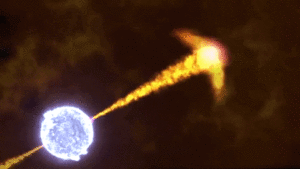
From the big freeze to the big crunch, planet x to strangelets converting all normal matter into strange matter. The likelihood of any of those events happening are very small. Nevertheless — that does not mean the Earth is not in danger of some cataclysmic event taking place before the sun swells into a red-giant, overtaking the orbits of the innermost planets in our solar system.
Now, I thought it was only fitting to discuss the possibility of a gamma-ray burst bathing our planet in deadly cosmic rays or gamma radiation…especially since most of the other scenarios are not nearly as horrifying as being baked alive, leaving the rest of the planet to die a slow, painful, suffocating death!
Gamma-ray bursts are a special flavour of a supernova. As the core of a massive stars collapses to form a black hole or a neutron star/pulsar, the outer layers explode outwards, producing two high-powered beams of gamma radiation. These gamma-ray bursts are capable of producing more raw energy than our sun will produce in its entire lifespan, all in a few quick moments.
While the beams are extremely energetic and damaging to anything that lies in their path, they are also very narrow. The beams would have to be aimed straight toward an object before striking it. Of course, there would be no warning, since the particles travel at nearly the speed of light. Thus, the particles would reach us at almost the same time as the light from the supernova.
If gamma ray bursts hit the earth, it would be capable of doing irreparable damage to Earth’s atmosphere — maybe even causing a mass extinction event that eradicates humankind entirely. Even a short burst that lasts 10 seconds could deplete over 25% of our ozone later, sending a barrage of ultraviolet rays to the surface of the planet. Even the damage our species has done to the ozone layer over thousands of years would be nothing in comparison to those numbers. The best estimate scientists have given thus far puts the depletion of the ozone layer between 3% to 4% to date.
A nearby gamma-ray burst could also trigger smog formation that’s capable of blocking out a percentage of our sunlight, potentially cooling the planet down exponentially. In this scenario, gamma rays would break apart nitrogen molecules in our air and transform them into nitrogen dioxide, which has a reddish-brown hue.
Since nitrogen dioxide is water-soluble, it would precipitate acid rain on our planet like the Earth’s evil twin, Venus. The side of our planet that was bathed in the radiation would be far more damaged than the side that was facing away at the time when it arrived.
It would be the equivalent of that entire portion of the planet being blasted with a nuclear explosion. In fact, evidence has been uncovered that suggests such a beam of radiation might have hit Earth back in the 8th century
let’s not panic! There are many uncertainties about these gamma-ray bursts that are not well understood. First, we aren’t sure when a nearby star will go supernova. It could happen any time in the next hundred or thousand years. Nor are we even sure if stars like WR 104 are capable of producing certain gamma-ray bursts in the first place. More gamma-ray bursts must be observed before the evidence is conclusive!
